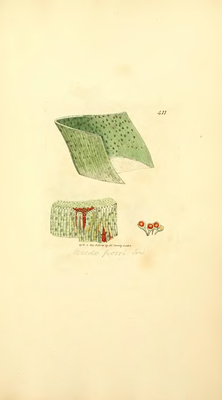Puccinia porri
| Puccinia porri | ||||||||||||
|---|---|---|---|---|---|---|---|---|---|---|---|---|

Puccinia porri |
||||||||||||
| Systematics | ||||||||||||
|
||||||||||||
| Scientific name | ||||||||||||
| Puccinia porri | ||||||||||||
| ( Sowerby ) winter |
Puccinia porri is a mushroom species from the order of the rust mushrooms (Pucciniales). The fungus is an endoparasite of various leeks . Symptoms of infestation by the species are rust spots on the leaf surfaces of the host plants. The distribution area includes a Holarctic area.
features
Macroscopic features
Puccinia porri can only be recognized with the naked eye by means of the spore beds emerging on the surface of the host. They grow in 1 × 1–5 mm large nests that appear as reddish to brown spots on the leaf surfaces.
Microscopic features
The mycelium of Puccinia porri grows as with all Puccinia TYPES intercellular and forms Saugfäden that grow into the storage tissue of the host. The aecia are cup-shaped and grow in elliptical rings. They have spherical to ovoid aecidiospores of 22–32 × 21–24 µm , which are hyaline and warty. The uredia are unstructured. Your uredospores are mostly ellipsoid, 28–32 × 21–28 µm in size, brown and warty. The parts of the species are rounded or oblong. The teleutospores are one- to two-, rarely three-celled, variably shaped and 17–63 × 17–24 µm in size; their stem is short and colorless.
Species delimitation
The leek rust ( Puccinia allii ) is very similar and is often considered a synonym. This has two-celled teliospores in the telia , which have paraphyses .
distribution
The distribution area of Puccinia porri covers the entire northern hemisphere.
ecology
The host plants of Puccinia porri are various leeks ( Allium spp.). The fungus feeds on the nutrients present in the storage tissue of the plants, its spore beds later break through the leaf surface and release spores. The species has a development cycle with Uredien, Telien and Aecidien. The fungus overwinters on infested plant remains or on leek stalks that remain in the bed over winter, or on chives growing nearby . Infested plant residues should therefore not be placed on the compost .
literature
- Ernst Gäumann: The rust fungi of Central Europe. With special consideration of Switzerland . In: Contributions to the cryptogam flora in Switzerland . tape XII . Commission publisher Buchdruckerei Büchler & Co, Bern 1959.